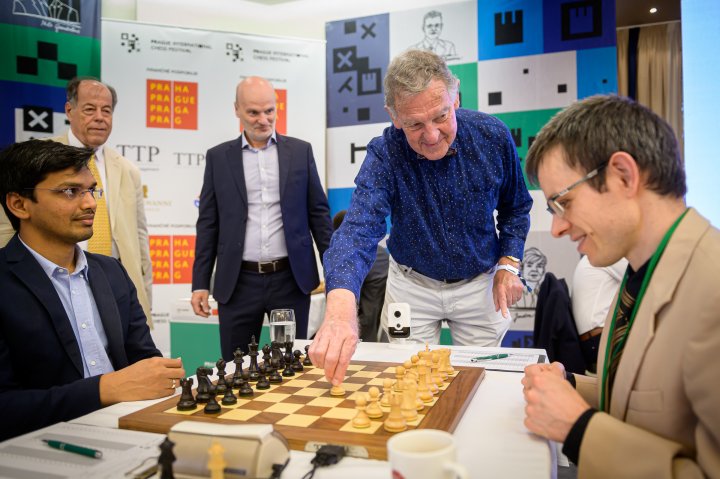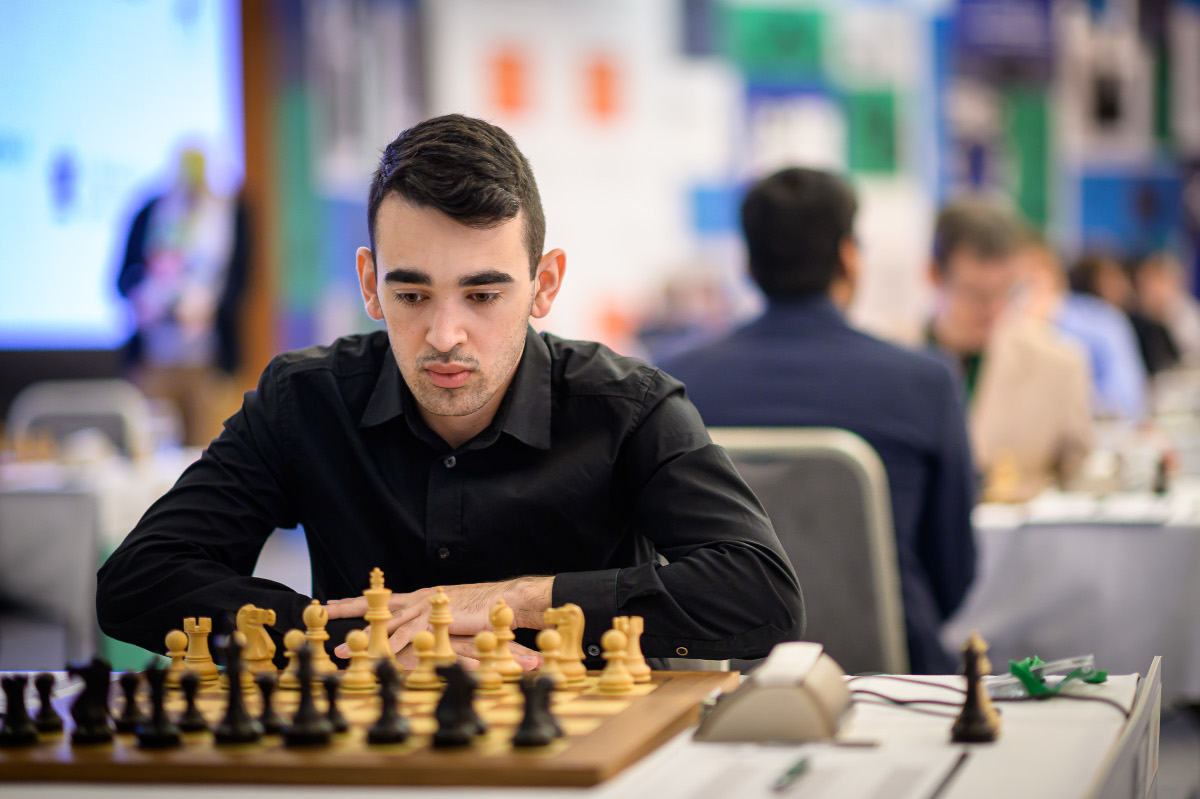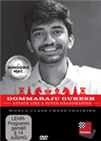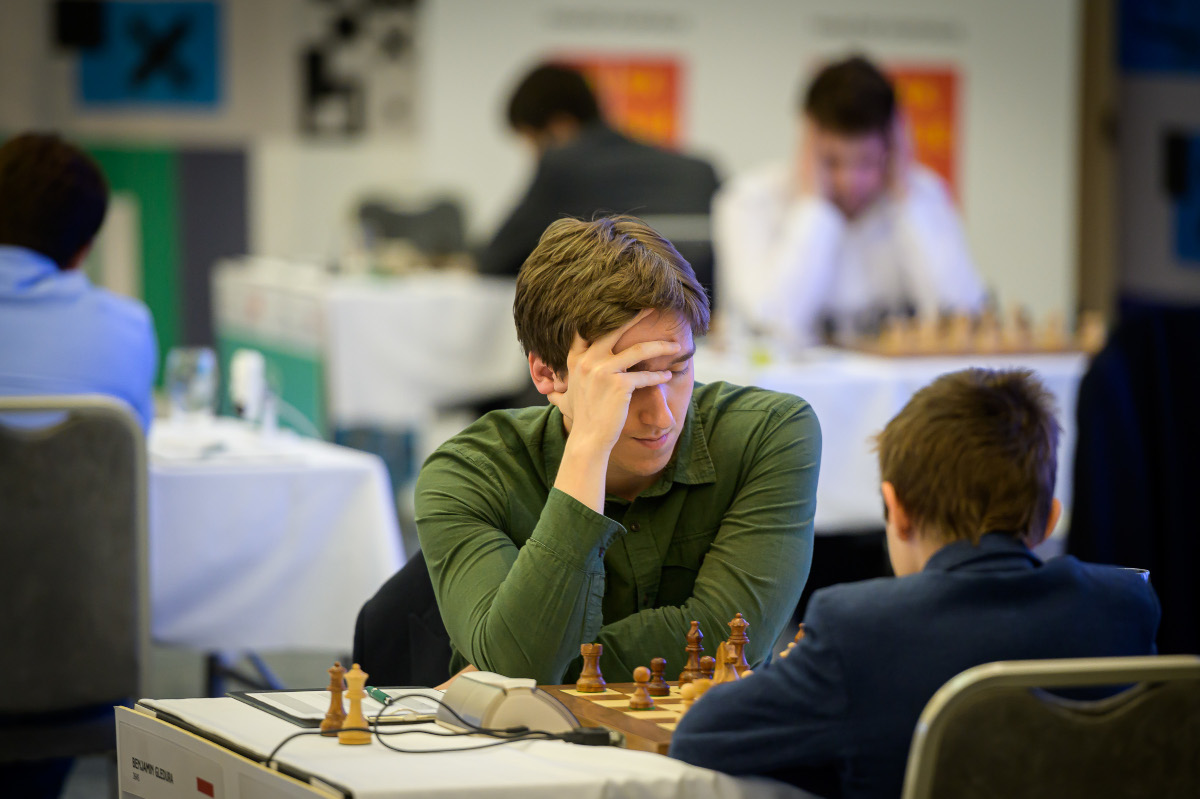Before the start of round 5

Before the beginning of the round tournament director Petr Boleslav (right) talks to Russell Armitage
Russell Armitage, a New Zealand writer and theatre man, is the author of "Czech Gambit", a play about Lubomir Kavalek, the famous US-Czech Grandmaster, who was born 9 August 1943 in Prague and died 18 January 2021 in the U.S. Armitage's play is based on Kavalek's autobiography "Life at Play", which was published posthumously in 2022 by New in Chess.
A Czech translation of "Czech Gambit" will have its premiere on Monday evening, 26 June, at 19.30 at the Theatro D21 in Prague as part of the side events of the Chess Festival.

Armitage makes the ceremonial first move in the game between David Navara (right, with White) and Pentala Harikrishna. Harikrishna, the main arbiter Pavel Votruba and Petr Boleslav are keen to see how Navara reacts.
Same line, same result
Ray Robson, who is now sharing the lead with Vincent Keymer and Bogdan-Daniel Deac in the Masters section of the Prague Chess Festival, played a third decisive game in a row in the Czech capital. The 28-year-old used the same line that gave him a full point on Friday, when he defeated Boris Gelfand in round 3. His rival this time around, Wang Hao, entered a safer variation at first, but the game nonetheless became double-edged, with Robson prevailing amid complications.
Much like in the Gelfand game, the Robson and Wang Hao needed plenty of time to deal with the complexities of the position since early in the middlegame. Robson spent half an hour grasping the nuances of the setup before playing his move number 17.
17.Qc1 is the computer’s first line, although placing the queen on c2 or b3 also made sense. No wonder Robson, a principled player, spent so much time at this critical juncture.
And that was just the start of a fantastic struggle — one that included moves like 32...Bf3 by Wang, in a position with major pieces still on the board, bishops of opposite colours and rather weakened monarchs.
White cannot capture the bishop with 33.gxf3 gxf3 34.Qxf3 due to 34...e2+ and White can resign. Instead, Robson correctly dealt with the situation via active play — 33.Rd8+ Kh7 34.Qd3+ Rg6 35.Bd4.
Wang still had a dangerous passer on the e-file, though.
Black lost a queen, and then immediately promoted his pawn to get a new one: 35...e2 36.Bxc5 e1Q+ 37.Qf1 Qe4, and White cannot grab the bishop now due to the rook on the g-file.
Note that the players had to calculate these lines from afar, with the clock ticking down dangerously!
Throughout the complex middlegame, the engines’ evaluation went from giving White a considerable advantage (not actually winning) to giving White only a small edge. It was only after Wang’s blunder on move 42 that the evaluation definitely favoured White.
 Let us learn together how to find the best spot for the queen in the early middle�game, how to navigate this piece around the board, how to time the queen attack, how to decide whether to exchange it or not, and much more!
Let us learn together how to find the best spot for the queen in the early middle�game, how to navigate this piece around the board, how to time the queen attack, how to decide whether to exchange it or not, and much more!42...Kg6 fails to 43.Rxf5 Kxf5 44.Qd5+ Kg6 45.f5+, gaining the rook on e6. Wang noticed his mistake and resigned immediately, not allowing Robson to show the winning line. It was surely a painful loss for the Chinese grandmaster, who came from beating Haik Martirosyan in the previous round.
It was a day of comebacks in the Masters, as Martirosyan bounced back from his loss against Wang by defeating Thai Dai Van Nguyen. By the way, Robson had also lost on Saturday.

Haik Martirosyan | Photo: Petr Vrabec
Results - Round 5
Standings - Round 5
All games
Challengers: Gledura leads with 4/5
Meanwhile, we got to enjoy an eventful round in the Challengers, with only the game between Alexander Motylev and Mateusz Bartel ending in a draw.
Benjamin Gledura, who entered the round sharing the lead with Bartel, collected a second consecutive win to become the sole leader with 4/5 points. Gledura’s bishop pair was clearly stronger than Vaclav Finek’s knight pair in a position with the g-file wide open (and both monarchs sitting on the kingside).
 In this Fritztrainer: “Attack like a Super GM” with Gukesh we touch upon all aspects of his play, with special emphasis on how you can become a better attacking player.
In this Fritztrainer: “Attack like a Super GM” with Gukesh we touch upon all aspects of his play, with special emphasis on how you can become a better attacking player.After 32...c5, opening up the light-squared long diagonal, the new sole leader needed six more moves to force his young opponent’s resignation.
Following the rest day, Gledura will play tail-ender Akash G with white, while second-placed Bartel will also get the white pieces in his game against Erwin l’Ami.

Benjamin Gledura | Photo: Petr Vrabec
Results - Round 5
Standings - Round 5
All games
Links
.jpeg)


























